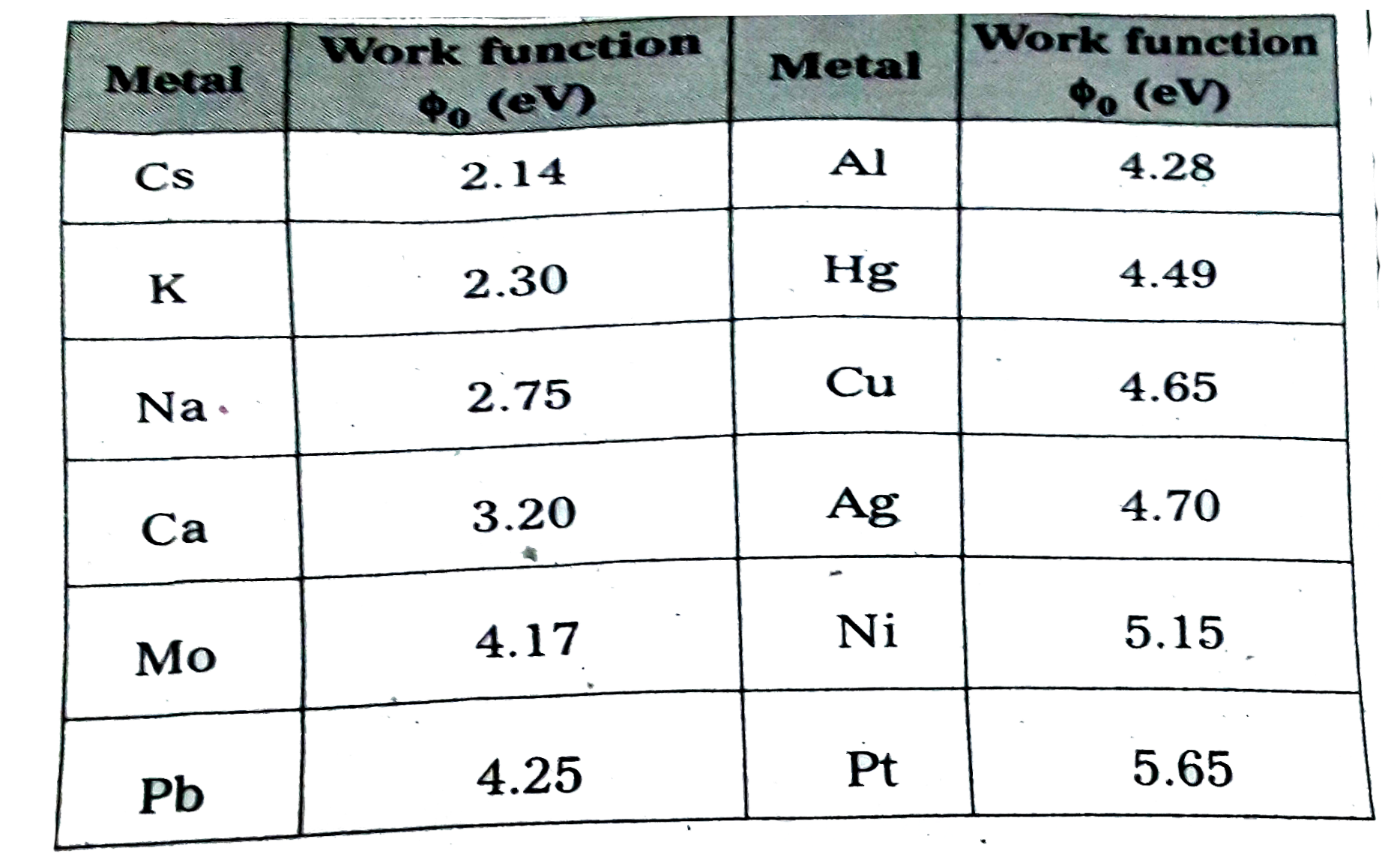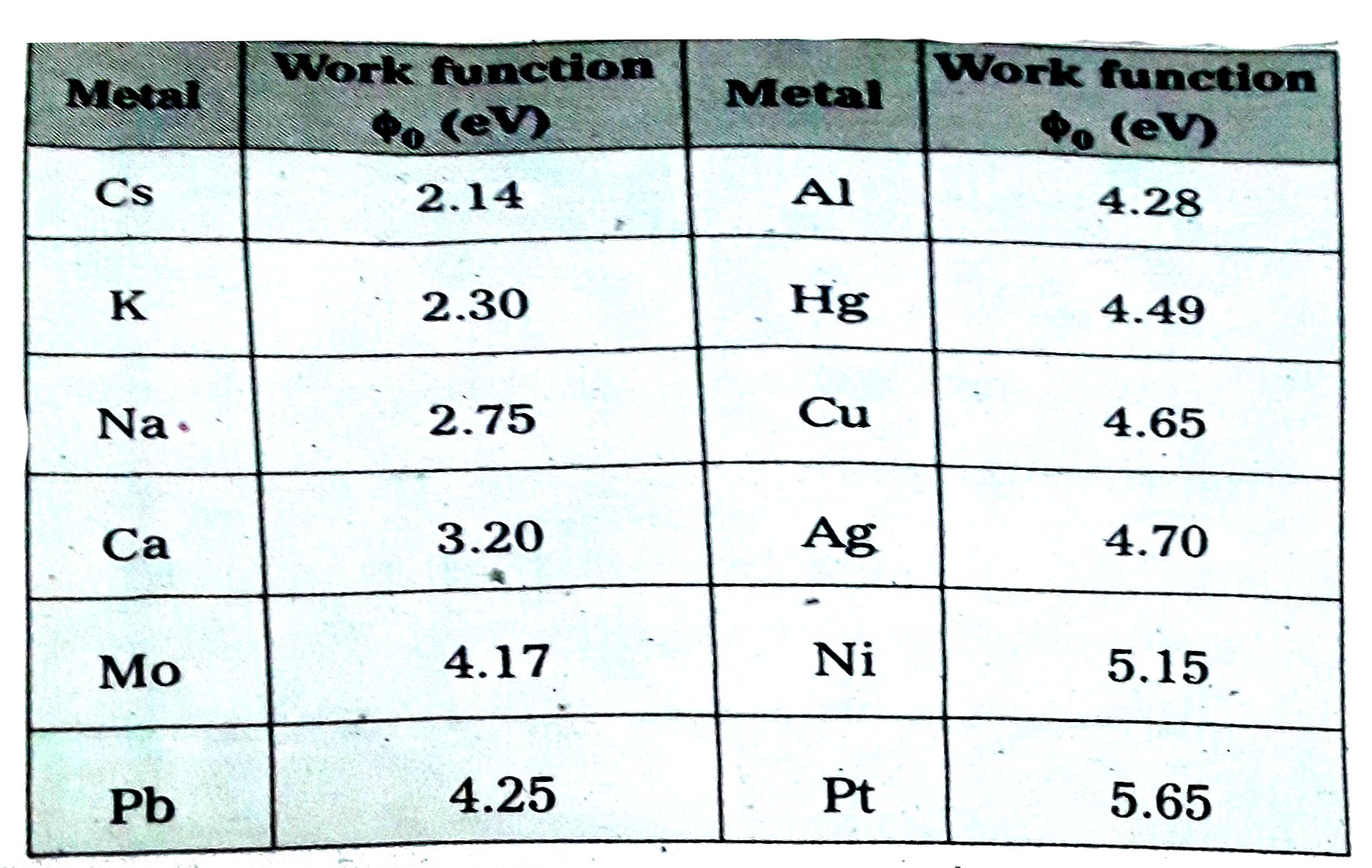The wavelength of light in the visible region is about 390 nm for violet colour ,about 550 nm (average wavelength) for yellow-green colour and about 760 nm for red colour.
(a)What are the energies of photons in (eV) at the (i) violet end, (ii)average wavelength,yellow-green colour,and (iii) red end of the visible spectrum ? (Take h=6.63×110−34) js and 1 eV=1.6×10−19J).
(b)From which of the photosensitive material with work functions listed n Table 11.1 and using the results of (i),(ii) and (iii) of (a), can you build a photoelectric device that operates with visible light?Solution in Gujrati
Here λv=390nm=39×10−8m
λyg=550nm=55×10−8m
λR=760nm=76×10−8m
h=6.63×10−34Js
leV=1.6×10−19J
c=3×108m/s
Energy of incident photon ,
E=hv=hcλ (in joule)
∴E=hceλ→(∈eV)
(i)For violet colour,
EV=hceλV=6.63×10−34×3×1081.6x10−19×39×10−8
∴EV0.31875×101
∴EV≈3.19eV
(ii) for yellow red light
Eyg=hceλyg=6.63×10−34×3×1081.6×10−19×5×10−8
∴Eyg=0.226×101
∴Eeg≈2.26eV
(iii) For red light,
ER=hceλR=6.63×10−34×3×1081.6×10−19×76×10−8
∴ER=0.163569×101
∴ER≈1.64eV
(b)
For photoelectric emission energy of incident light should be equal or more than work function of metal.
Here energy of violet light is EV=3.19eV Which is more than work function of Na ,K and Cs hence photoelectric device will work which depend on radiation of violet colour.
Energy of yellow light Eyg=2.26 eV which is more than work function of CS hence photoelectric device will work which depend on radiation of yello-green colour.
Energy of red colour is ER=1.64 eV which is less than work function of metals given in table.Hence photoelectric device which work on red colour will not work.
Topper's Solved these Questions
- BOOK - KUMAR PRAKASHANCHAPTER - DUAL NATURE OF RADIATION AND MATTEREXERCISE - Section-B Numerical from textual Exercise19videos
DUAL NATURE OF RADIATION AND MATTER
- BOOK - KUMAR PRAKASHANCHAPTER - DUAL NATURE OF RADIATION AND MATTEREXERCISE - Section-B Numerical from textual Exercise(Additional Exercise)18videos
DUAL NATURE OF RADIATION AND MATTER
- BOOK - KUMAR PRAKASHANCHAPTER - DUAL NATURE OF RADIATION AND MATTEREXERCISE - Section-A Example2videos
DUAL NATURE OF RADIATION AND MATTER
- BOOK - KUMAR PRAKASHANCHAPTER - CURRENT ELECTRICITYEXERCISE - SECTION [D] MULTIPLE CHOICE QUESTIONS (MCQs) (MCQs ASKED IN BOARD EXAM AND GUJCET)23videos
CURRENT ELECTRICITY
- BOOK - KUMAR PRAKASHANCHAPTER - ELECTRIC CHARGES AND FIELDS EXERCISE - SECTION D MCQS ASKED IN COMPETITIVE EXAMES (MCQS AKSED IN BOARD EXAM AND GUJCET)14videos
ELECTRIC CHARGES AND FIELDS
Similar Questions
Find the
(a)Maximm frequency,and
(b)Minimum wavelength of X-rays produced by 30 kV electrons.05:01View Solution(a) Estimate the speed with which electrons emitted from a heated emitter of an evacuated tube impinge on the collector maintained at a potential difference of 500 V with respect to the emitter.Ignore the small initial speeds of the electrons.The specific charge of the electron ,i.e., its
em is given to be 1.76×1011Ckg−1
(b) Use the same formula you employ in (a)to obtain electron speed for an collector potential of 10 MV.Do you see what is wrong ?in what way is the formula to be modified?02:03View SolutionFor electron moving with speed of 20 m/s and accelerated by 120 V p.D. de-Broglie wavelength can be easily obtained.
05:24View SolutionA wire is bent in the form of circle of radius 2m. Resistance per unit length of wire is 1πΩm. Battery of 6 V is connected between A and B ∠AOB=90∘ . Find the current through the battery.
 07:57View Solution
07:57View SolutionWhen air is replaced by dielectric medium of constant K, the maximum force of attraction between two charges separated by distance d, ..........
07:34View SolutionThe wavelength of light in the visible region is about 390nm for violet colour, about 550nm (average wavelength) for yellow green colour and about 760nm for red colour. What are the energies of photon in eV at the (i) violet end (ii) average wavelength yellow-green colour and (iii) red end of the visible spectrum? (Take h=6.63×10−34Jsand1eV=1.6×10−19Js)
09:44View SolutionThe wavelength of light in the visible region is about 390 nm for violet colour and about 760 nm for red colour. The energy of photon in eV at violet end is
02:47View SolutionThe wavelength of light in the visible region is about 390 nm for violet colour, about 550 nm (average wavelength ) for yellow - green colour and about 760 nm for red colour .
(a ) What are the energies of photons in (ev) at the (i) violet end, (ii) average wavelength , yellow - green colour , and (ii) red end of the visible spectrum ? (Take h = 6.63×10−34 J s and 1 eV= 1.6×10−19 J ) ,
 05:24View Solution
05:24View SolutionThe wavelength of light in the visible region is about 390 nm for violet colour, about 550 nm (average wavelength ) for yellow - green colour and about 760 nm for red colour .
From which of the photosensitive materials with work functions listed in table and using the results of (i) , (ii) and (iii) of (a) can you build a photoelectric device that operates with visible light ?
 View Solution
View Solutionदृश्य क्षेत्र में बैंगनी रंग ,पिले-हरे रंग तथा लाल रंग के प्रकाश के तरंगदैर्घ्य क्रमशः लगभग 390n,m,500nm (औसत तरंगदैर्ग्य) तथा 760nm है।
दृश्य क्षेत्र के निम्न प्रकाश के लिए फोटॉन की ऊर्जा (eV में) क्या होगी-
(i) बैगनी सिरा (ii) पिले-हरे रंग औसत तरंगदैर्घ्य तथा (iii) लाल सिरा।
[h=6⋅63×10−34Js तथा 1eV=1⋅6×10−19J]07:07View Solutionदृश्य क्षेत्र में बैंगनी रंग, पीले-हरे रंग तथा लाल रंग के प्रकाश की तरंगदैर्ध्य क्रमश: लगभग 390 nm, लगभग 550 nm (औसत तरंगदैर्ध्य) तथा लगभग 760 nm है।
(a) दृश्य क्षेत्र के निम्न प्रकाश के लिए फोटॉन की ऊर्जा (eV) क्या होगी - (i) बैंगनी सिरा, (ii) पीले-हरे रंग की औसत तरंगदैर्ध्य, तथा (iii) लाल सिरा (h=6.63×10−34Js तथा 1eV=1.6×10−19J)
(b) प्रकाश-संवेदी पदार्थों के लिए सारणी में दिए गए कार्य-फलनों के मान तथा (a) प्रश्न के (i), (ii) तथा (iii) भागों के परिणामों को उपयोग में लाते हुए क्या आप दृश्य प्रकाश के साथ कार्य कर सकने वाली प्रकाश विद्युत युक्ति का सृजन कर सकते हैं?08:48View SolutionArrange these colours in an increasing order of wavelength :
red, violet, yellow, green07:07View SolutionThe wavelength of light in the visible region is about 390 nm for violet colour, about 550 nm (average wavelength ) for yellow - green colour and about 760 nm for red colour .
(a ) What are the energies of photons in (ev) at the (i) violet end, (ii) average wavelength , yellow - green colour , and (ii) red end of the visible spectrum ? (Take h = 6.63×10−34 J s and 1 eV= 1.6×10−19 J ) ,
 View Solution
View SolutionThe wavelength of light in the visible region is about 390 nm for violet colour, about 550 nm (average wavelength) for yellowgreen colour and about 760 nm for red colour. (a) What are the energies of photons in (eV) at the (i) violet end, (ii) average wavelength, yellow-green colour, and (iii) red end of the visible spectrum? (Take h =6.63×10−34 J s and 1 eV=1.6×10−19J.)
(b) From which of the photosensitive materials with work functions listed in Table 11.1 and using the results of (i), (ii) and (iii) of (a), can you build a photoelectric device that operates with visible light?07:53View SolutionThe wavelength of light in the visible region is about 390 nm for violet colour, about 550 nm (average wavelength) for yellowgreen colour and about 760 nm for red colour. What are the energies of photons in (eV) at the (i) violet end, (ii) average wavelength, yellow-green colour, and (iii) red end of the visible spectrum? ("Take h "= 6.63xx10^(-34)" J s and 1 eV" = 1.6xx10^(-19)J.)
04:18View Solution

